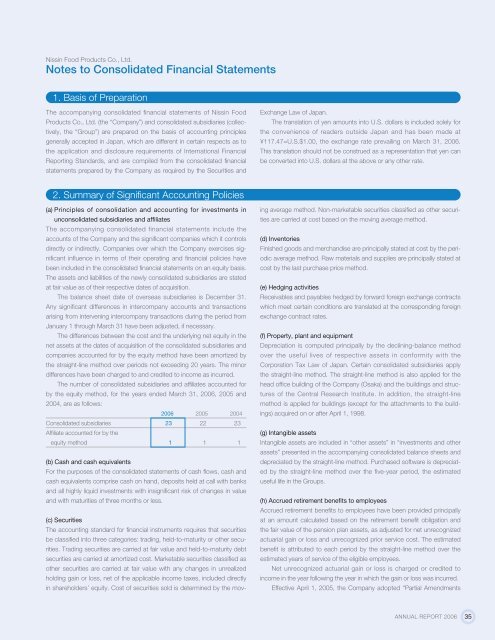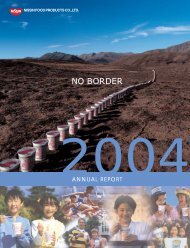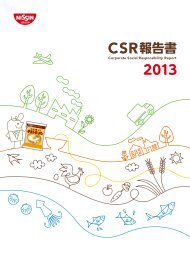NO BORDER
NO BORDER
NO BORDER
You also want an ePaper? Increase the reach of your titles
YUMPU automatically turns print PDFs into web optimized ePapers that Google loves.
Nissin Food Products Co., Ltd.<br />
Notes to Consolidated Financial Statements<br />
1. Basis of Preparation<br />
The accompanying consolidated financial statements of Nissin Food<br />
Products Co., Ltd. (the “Company”) and consolidated subsidiaries (collectively,<br />
the “Group”) are prepared on the basis of accounting principles<br />
generally accepted in Japan, which are different in certain respects as to<br />
the application and disclosure requirements of International Financial<br />
Reporting Standards, and are compiled from the consolidated financial<br />
statements prepared by the Company as required by the Securities and<br />
Exchange Law of Japan.<br />
The translation of yen amounts into U.S. dollars is included solely for<br />
the convenience of readers outside Japan and has been made at<br />
¥117.47=U.S.$1.00, the exchange rate prevailing on March 31, 2006.<br />
This translation should not be construed as a representation that yen can<br />
be converted into U.S. dollars at the above or any other rate.<br />
2. Summary of Significant Accounting Policies<br />
(a) Principles of consolidation and accounting for investments in<br />
unconsolidated subsidiaries and affiliates<br />
The accompanying consolidated financial statements include the<br />
accounts of the Company and the significant companies which it controls<br />
directly or indirectly. Companies over which the Company exercises significant<br />
influence in terms of their operating and financial policies have<br />
been included in the consolidated financial statements on an equity basis.<br />
The assets and liabilities of the newly consolidated subsidiaries are stated<br />
at fair value as of their respective dates of acquisition.<br />
The balance sheet date of overseas subsidiaries is December 31.<br />
Any significant differences in intercompany accounts and transactions<br />
arising from intervening intercompany transactions during the period from<br />
January 1 through March 31 have been adjusted, if necessary.<br />
The differences between the cost and the underlying net equity in the<br />
net assets at the dates of acquisition of the consolidated subsidiaries and<br />
companies accounted for by the equity method have been amortized by<br />
the straight-line method over periods not exceeding 20 years. The minor<br />
differences have been charged to and credited to income as incurred.<br />
The number of consolidated subsidiaries and affiliates accounted for<br />
by the equity method, for the years ended March 31, 2006, 2005 and<br />
2004, are as follows:<br />
2006 2005 2004<br />
Consolidated subsidiaries 23 22 23<br />
Affiliate accounted for by the<br />
equity method 1 1 1<br />
(b) Cash and cash equivalents<br />
For the purposes of the consolidated statements of cash flows, cash and<br />
cash equivalents comprise cash on hand, deposits held at call with banks<br />
and all highly liquid investments with insignificant risk of changes in value<br />
and with maturities of three months or less.<br />
(c) Securities<br />
The accounting standard for financial instruments requires that securities<br />
be classified into three categories: trading, held-to-maturity or other securities.<br />
Trading securities are carried at fair value and held-to-maturity debt<br />
securities are carried at amortized cost. Marketable securities classified as<br />
other securities are carried at fair value with any changes in unrealized<br />
holding gain or loss, net of the applicable income taxes, included directly<br />
in shareholders’ equity. Cost of securities sold is determined by the moving<br />
average method. Non-marketable securities classified as other securities<br />
are carried at cost based on the moving average method.<br />
(d) Inventories<br />
Finished goods and merchandise are principally stated at cost by the periodic<br />
average method. Raw materials and supplies are principally stated at<br />
cost by the last purchase price method.<br />
(e) Hedging activities<br />
Receivables and payables hedged by forward foreign exchange contracts<br />
which meet certain conditions are translated at the corresponding foreign<br />
exchange contract rates.<br />
(f) Property, plant and equipment<br />
Depreciation is computed principally by the declining-balance method<br />
over the useful lives of respective assets in conformity with the<br />
Corporation Tax Law of Japan. Certain consolidated subsidiaries apply<br />
the straight-line method. The straight-line method is also applied for the<br />
head office building of the Company (Osaka) and the buildings and structures<br />
of the Central Research Institute. In addition, the straight-line<br />
method is applied for buildings (except for the attachments to the buildings)<br />
acquired on or after April 1, 1998.<br />
(g) Intangible assets<br />
Intangible assets are included in “other assets” in “investments and other<br />
assets” presented in the accompanying consolidated balance sheets and<br />
depreciated by the straight-line method. Purchased software is depreciated<br />
by the straight-line method over the five-year period, the estimated<br />
useful life in the Groups.<br />
(h) Accrued retirement benefits to employees<br />
Accrued retirement benefits to employees have been provided principally<br />
at an amount calculated based on the retirement benefit obligation and<br />
the fair value of the pension plan assets, as adjusted for net unrecognized<br />
actuarial gain or loss and unrecognized prior service cost. The estimated<br />
benefit is attributed to each period by the straight-line method over the<br />
estimated years of service of the eligible employees.<br />
Net unrecognized actuarial gain or loss is charged or credited to<br />
income in the year following the year in which the gain or loss was incurred.<br />
Effective April 1, 2005, the Company adopted “Partial Amendments<br />
ANNUAL REPORT 2006<br />
35





